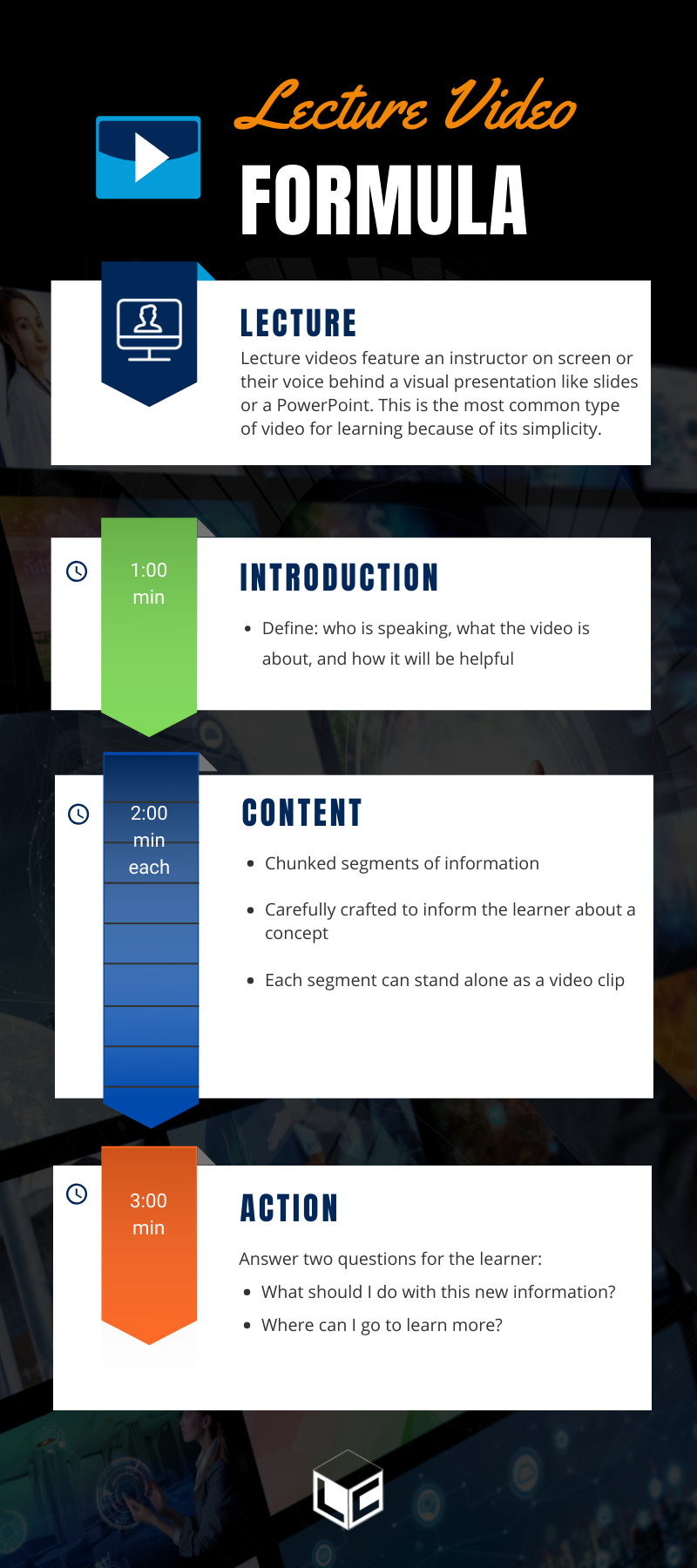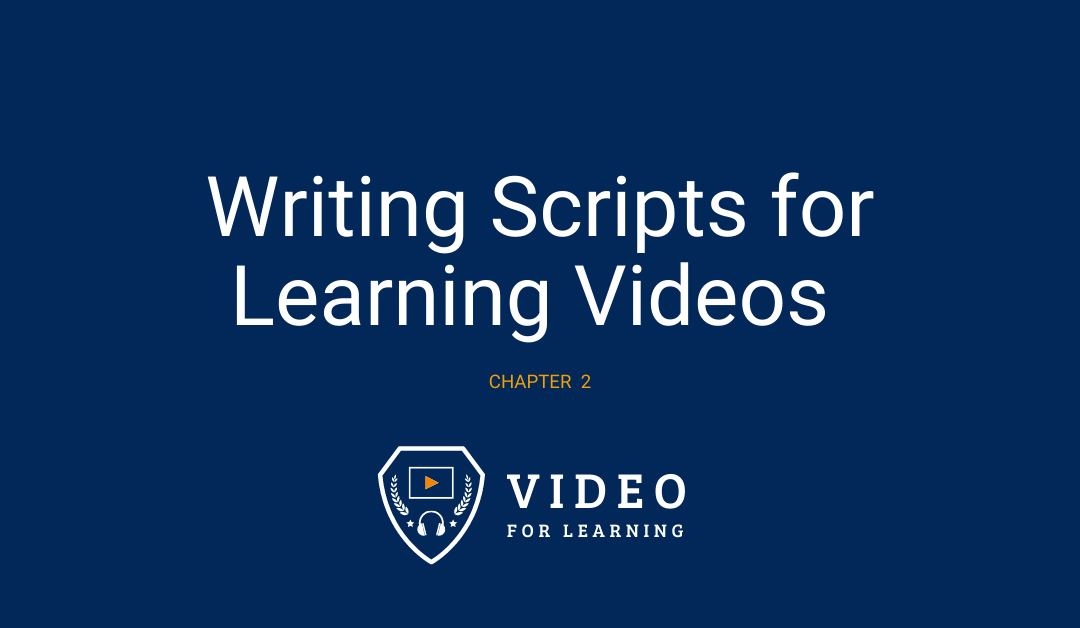Writing scripts for learning videos is not easy. It takes form, function, practice and method. I’m on a mission to help you make better learning videos. I used to be a teacher before I became a video production manager. Now, I’m passing my experience along to you through the Video for Learning (VFL) program. Each part of the VFL framework is designed with action steps to transform your video creator skills.
This is chapter 2 of the VFL program. Chapter 1, Fundamentals, is worth the read if you are just getting started or like to learn the theory behind the practice.
“Don’t tell me the moon is shining; show me the glint of light on broken glass.” –Anton Chekov
Key Scriptwriting Concepts
Writing for the small screen, especially a screen used to aid in the learning process, is like learning to drive a manual transmission after driving automatic cars for years. The basics are the same, but now there is a new set of steps to follow in order to keep the engine moving in the right direction.
For example, you must have a mastery understanding of the writing process, a wide vocabulary, a consistent style, and knowledge of proper grammar and punctuation. To make your writing work on the small screen specifically for learning purposes, you also must master the instructional design process and adhere to its best practices. And, you need a cursory understanding of screenwriting.
When you are creating scripts for learning, you must become well versed in writing for narration, dialogue, and screen action. In order to learn these new skills, I’ve organized this chapter into three sections: Knowledge, Skills, and Best Practices.
Whether you are completely new to writing video scripts for learning or you are an experienced writer, please read through this chapter linearly.
“You don’t start out writing good stuff. You start out writing crap and thinking it’s good stuff, and then gradually you get better at it. That’s why I say one of the most valuable traits is persistence.” ― Octavia E. Butler
THE KNOWLEDGE
The Mindset for Writing Learning Videos
In order to deliver on the promise of video for learning, you need to have an open-minded, inquisitive and fiercely dedicated mindset. If you are going to improve the knowledge, skills, and behaviors of your audience, then I suggest letting go of your biases and your ego as it relates to the content. Be consistent in your approach to method and style. Focus on the details so that you always, always, share error-free versions with your reviewers. And finally, omit needless words. Now close your eyes, listen to the soft piano play the introduction as Elsa climbs her flowing magenta cape up the side of the frozen mountain. It’s time to “Let it go!”
Read the full post: The Mindset
The Procedure of Scriptwriting for Learning Videos

Scriptwriting is where instructional design meets creativity. Both are necessities for creating a successful learning video! Once you choose your instructional design method, you’ll complete the steps to create learning objectives and start writing a script that will improve the knowledge, skills, or behaviors of your target learner audience. Your script’s structure will depend on which type of learning video is the most suitable for your subject matter and learning objectives. The best way to start writing a script is to start writing a script. It takes practice, repetition, and perseverance. You can do it!
Three elements of scriptwriting:
- The Models: ADDIE, SAM, & SAM2
- Learning Objectives
- Types of Learning Videos (6)
Read the full post: Scriptwriting for Learning Video
THE SKILLS
The Writing Process for Learning Videos

Writing is a skill that takes practice and confidence. Most importantly, confidence is the result of practice. Using an iterative writing process will yield a document ready for actors and the production crew. Remember: you are writing for the small screen. So, offer natural lines for your actors that allow them to show instead of telling the viewer important information aimed at improving their knowledge, skills, or behavior. That is the goal, after all! As you internalize this process, your ability to write creatively will increase. And, in conclusion, you’ll be able to expand the variety of learning video types you feel comfortable creating.
Read the full post: The Writing Proces
4 Must-Have Scriptwriter Skills
Learning storyboardese will not only help you communicate within the instructional design world, but it will also enable you to combine that world with the video production universe to make excellent learning videos. Knowing what information you need to include in a script can be half the battle, as it’s often easier to write when you have a template, structure, or guidelines for your script in mind. Providing actor and screen directions along with realistic dialogue is crucial to producing the video you want AND the video you need. The goal is to make sure that every decision and note you make accomplishes the desired learning objectives, which, in turn, tackle the business problems at hand.
- Learn Storyboardese
- Use Actor Direction and Production Notes
- Use a Matrix to Discover Realistic Dialogue
- Write Screen Direction
Read the full post: Four Scriptwriter Skills
BEST PRACTICES & FORMULAS
5 Best Practices for Learning Video Scriptwriters
Sheer practice along with using best practices helps us become better writers. Following or mindfully breaking the 2-minute rule will help you keep the learner’s experience at the forefront of your mind and avoid dumping information. If you internalize the 135 wpm metric, you will quickly be able to use word count to determine if you are nearing the threshold of a dreaded information dump. Revision cycles are important for drafting and delivering realistic dialogue. Once you gain comfort in doing table reads, it will be easier to move your scripts through two revision cycles with your client. Throughout all of your writing make sure to keep kindness at your core. Our clients have hired us to do something they don’t have time to do themselves. Take a breath, be patient, and know that you are helping bring visual life to a concept someone needs to improve their knowledge, skills or behavior and ultimately get better at their job.
See the full glossary: 5 Best Practices as a Learning Video Scriptwriter
Three Learning Video Storytelling Formulas

The quest to write better video scripts for learning requires us to keep working at it. Using templates and formulas to speed up the process will help you. The three common storytelling formulas for learning video will help you build upon proven forms that your learning audiences will expect. As you craft your scripts using these formulas, always keep sight of the purpose of learning video: to improve the knowledge, skills, and behaviors of the learner. And by all means, keep writing! You will be better tomorrow than you are today!
- Lecture Video Formula
- How-To Video Formula
- Explainer Video Formula
Read the full post: 3 Learning Video Storytelling Formulas
Summary
As you create your video for learning script, revisit the concepts and best practices in this chapter. Remember that learning video scripts are unique from others in that they are trying to meet a very specific learning objective. Your goal in creating video for learning is to improve knowledge, skills, and/or behaviors. Treat the writing process as your friend. Spend time with it, and use proven screenwriting and instructional design techniques to grow your friendship. Try to keep your scripts as short as the content will allow. Finally, follow the video formulas and remember to include actor and scene directions and a prop list to your script. When the shoot day comes, you’ll be glad you did!


